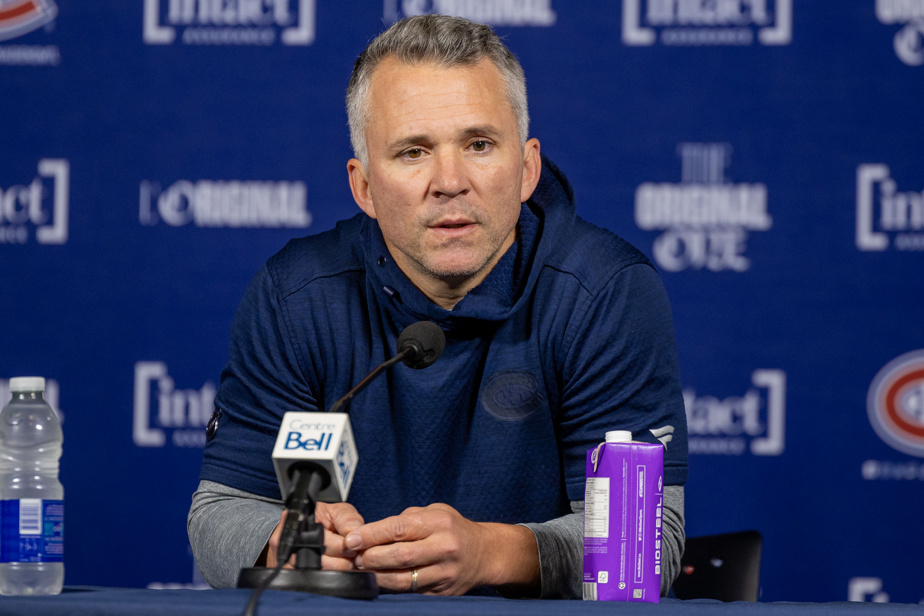(Las Vegas) In January 2022, a tragedy of unspeakable sadness shook Fairfield County, Connecticut. A 15-year-old hockey player, Terry Balkind, died after having his throat cut by a skate during a game between two high schools.
Martin St-Louis has not forgotten anything about this tragedy. That evening, St. Luke’s School, for which Balkind played, took on Brunswick School, which his youngest son, Lucas, then attended. The latter, however, was not involved in this meeting since he was a little older than Balkind.
The small neighboring communities of Greenwich and New Canaan had been greatly shaken. On Twitter, as a sign of solidarity, St. Louis, like its fellow citizens, published a photo of hockey sticks on the steps of the family home. “For Teddy,” he wrote.
When it learned of the tragic accident that cost the life of Adam Johnson last weekend, St. Louis relived a bad memory. Johnson, 29, a former member of the Pittsburgh Penguins organization, had his throat cut Saturday during a Nottingham Panthers game in the English Elite League. He died over the next few hours.
“It’s a terrible accident,” admitted St-Louis, Monday morning, after CH training.
The day after the event, players from the Providence Bruins in the American League adopted the neck protector, a piece of equipment that is essentially non-existent in professional hockey. The Rochester Americans, the Buffalo Sabres’ farm club, have just ordered some, revealed Monday journalist Patrick Williams, who follows the activities of the American League. And the England Hockey Association will make its wearing compulsory from 1er January 2024 across the country.
If Martin St-Louis doubts that this regulation will make its way to the NHL, he says he is strongly in favor of young players, “those under 18 or 20 years old”, being obliged to better protect this part of their body . Because an accident like the one that cost Adam Johnson’s life, “it doesn’t happen often, but it happens the same way,” he recalled.
Like the visor
The discussion sparked by this tragedy is reminiscent of those which led to the adoption of helmets by NHL players, then to that of the visor.
Traditionally, a “grandfather” clause has allowed older players to retain their former privileges. “Maybe the league will go in that direction” with the neck protector, raised Brendan Gallagher, visibly not keen on the idea. “If something new” emerges from this situation, “it could be a good thing,” continued Nick Suzuki with more confidence. Because, ultimately, “guys want to be safe.”
Craig MacTavish was the last to play without a helmet, until his retirement in 1997. Since Zach Kassian’s retirement a few days ago, there are only seven players who skate without a visor.
Martin St-Louis adopted the visor in 2011 after receiving a puck in the face during a Tampa Bay Lightning practice. His vision was never the same again on the left side. “I’m watching today’s game… It’s stupid, the throws, the sticks on the pucks, the speed of the game… I would have a hard time playing without a visor. In fact, I can’t believe I played without a visor. »
Is last Saturday’s incident likely to change things? “Yes, it can,” he agreed. Although in his eyes, NHL players have “more control” than those who play in other leagues.
This did not prevent Richard Zednik from being hit in the neck by the skate of his teammate Olli Jokinen, in 2008. And no one has forgotten the images of goalie Clint Malarchuk, in 1989, in the middle of his bloody semi-circle .
Reflection
The death of Adam Johnson sent shock waves through the hockey world. Some Canadian players shared tributes on social networks. Obviously, this accident has animated their discussions over the past few days. But it’s not tomorrow that we’ll see neck protectors appear in their equipment bags.
As a good politician, Brendan Gallagher said that a “conversation” would take place on this subject, but that for the moment, he preferred to dedicate his thoughts to Johnson and his family.

PHOTO DOMINICK GRAVEL, LA PRESSE ARCHIVES
Brendan Gallagher
One of his friends, Josh Nicholls, plays for the Sheffield Steelers, opponents of the Nottingham Panthers on Saturday. He had the opportunity to speak to him and see the extent of the trauma experienced by the people there. However, this will not change his approach to the game, he assures. “When you’re on the ice, you shouldn’t think about that. We understand the risks. [Ce qui est arrivé] is unfortunate, but the chances of it happening again are slim. »
Since neck guards are not mandatory in minor hockey in the United States, Jordan Harris has never worn one in his life. “I never thought about it too much,” admits the one who would nevertheless be “ready to try it.” Kaiden Guhle, for his part, abandoned this piece of equipment imposed on young Canadian hockey players as soon as he could. He remembers how warm his neck gaiter made him. He has therefore no longer worn one since his accession to the junior ranks.
However, he points out that anyone who wishes is free to wear one. Which would make sense in a sport where sticks and skate blades “are essentially weapons.”
Of the group present in the CH locker room Monday morning, it was probably Rafaël Harvey-Pinard who seemed the most advanced in his thinking. “It can happen to anyone,” he said. Maybe a life could have been saved with a neck protector. »
Will he be the first in his camp to wear one? “We should try it in training,” he replied. It’s been a few years since I last wore one, I don’t know if it would bother my breathing. But yes, it’s an option that I will consider. »
“I think everyone in the league will think about it,” he concluded. In any case, if I have to put one in, I won’t argue, that’s for sure. »
